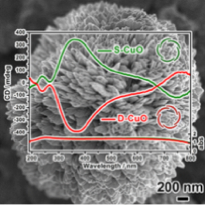
Construction and Mechanism Research of Chiral-Mesoscopic Inorganic Materials
(1) Construction and properties of chiral-porous-mesoscopic inorganic materials
(1.1) Construction of chiral-porous-mesoscopic materials
Chirality is widely expressed in organic materials, perhaps most notably in biological molecules, owing to the homochirality of their components (d-sugars and l-amino acids). Here we report the surfactant-templated synthesis of ordered chiral mesoporous silica, from experiments we found that only at some extremely limited rations of anionic surfactants and co-structure directing agent could form the expected chiral structures. The material that we have synthesized has a twisted hexagonal rod-like morphology, with diameter 130–180 nm and length 1–6 m. Transmission electron microscopy combined with computer simulations confirm the presence of hexagonally ordered chiral channels of 2.2 nm diameter winding around the central axis of the rods, and the maximal ratio of left-handed and right-handed rods was 7.5:2.5. This work was published on Nature , 2004, 429, 281.
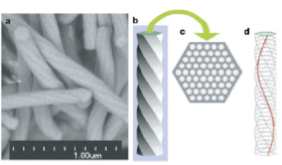
(1.2) Review on Chiral mesoporous silica: chiral construction and Imprinting via cooperative self-assembly of amphiphiles and silica precursors
Fabrication of chiral materials and revealing the mechanisms involved in their formation are crucial issues in scientific research. The combination of cooperative self-assembly routes and the chiral templating process favors the formation of inorganic chiral materials with highly ordered mesostructures. This tutorial review highlights the recent research on chiral mesoporous silica (CMS) of hierarchical helical constructions transcribed from organic templates. The rules and mechanisms involved in the synthesis of CMS and related materials, especially the novel expression of chirality and imprinting of helical micellar superstructure by the functional groups immobilized on the mesopore surface, provide us with a deeper insight into the chiral self-assemby process and new strategies for the design and application of chiral materials. This review is addressed to researchers and students interested in chiral chemistry, supramolecular chemistry and mesoporous materials. This review was published on Chem. Soc. Rev., 2011, 40, 1259.
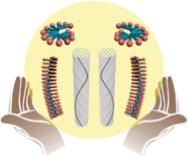
(2) Construction and properties of chiral-porous-mesoscopic inorganic material
(2.1) Synthesis of a DNA–Silica complex with rare Two-Dimensional square p4mm symmetry
Studying genetic material to control the two- and three- dimensional packing of biomolecular-scale building blocks into well-defined meso- and macroscopic structures is useful for understanding the mechanisms involved in living organ- isms, and assists application in biotechnology, nanotechnology, and materials chemistry. Meters of genetic material are naturally packed into compact structures by a variety of methods that are optimized for specific requirements. Although many forms of countering induced DNA liquid crystals (LCs), such as chiral nematic, uniaxial columnar, and higher-ordered columnar phases, as well as supramolecular-directed DNA LCs with lamellar and columnar phases, have been studied extensively, the packing behavior of DNA in vivo is not fully understood, and structures mimicking silica mineralization in vitro remain unresolved.
We reported for the first time the synthesis of a DNA–silica complex (DSC) with a rare two–dimensional (2D)–square p4mm structure together with the structural analysis using electron microscopy. Based on the cooperative effects of quaternary ammonium silane, both acting as a DNA condensing agent through the positively charged quaternary ammonium group and stabilizing silica mineralization by co–condensing silane with the silica source, 2D-square p4mm and 2D–hexagonal p6mm symmetries have been synthesized under different DNA concentration, which gives rise to a new DNA LC phase diagram. The small interaxial separation of ~25 Å formed upon quaternary ammonium–phosphate electrostatic “zipping” along the DNA–DNA contacts according to the simulation results based on Kornyshev-Leikin theory, and the silica wall formed between the DNAs in the diagonal position were considered to be optimal for the formation of the p4mm structure. This work has been published on Angew. Chem. Int. Ed., 2009, 48, 9268.
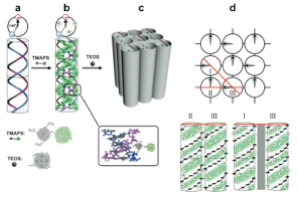
(2.2) Synthesis of a DNA–Silica complex with helical structures
The helicity of DNA and its long-range chiral packing are inspiring phenomena; however, the packing mechanism remains poorly understood, both in vivo and in vitro. Here, we report the extraordinary enantiomeric chiral self-assembly of DNA by silica mineralization, together with circular dichroism measurements and electron microscopy studies on the structure and morphology of the products. Alkaline earth metal ions were found to induce DNA chiral packing of two-dimensional square p4mm mesostructures to give impeller-like helical DNA-silica complexes (IHDSCs). Enantiomeric IHDSCs were formed by tuning temperature, pH value and quaternary ammonium:DNA molar ratio due to the antipodal DNA layer-by-layer chiral packing. It has been suggested that the alkaline earth metal ions favor the stabilization of right-handed DNA helical stacking, while the chirality can be readily reversed by increasing the interaction between DNA and quaternary ammonium groups. This work has been published on Angew. Chem. Int. Ed., 2012, 51, 923 and selected as VIP paper.

(2.3) Synthesis of a DNA–Silica complex with patterning structures
The artificial organization of nature-inspired, biomolecule-templated hierarchical inor- ganic materials is a key challenge in enabling many nano- technological applications. Template-assisted self-assembly (TASA) combines bottom-up self-assembly with top-down patterned templates to eliminate defects and induce registration and orientation in thin-film materials, providing rich opportunities to produce biomimetic multilevel hierarchies. In this article, combing the pre-reported DNA-silica plates (DSPs) synthesis method, we selectively aligned, placed, and arranged DSPs at different positions on patterned silicon substrate surfaces by thermodynamically and kinetically controlling DSP formation, which depends on the charge density of the quaternary ammonium groups, which in turn depends on their positions on the patterned silicon substrate, the ionization degree of DNA, and the TMAPS concentration. Herein, unpatterned silicon substrates were used to control the alignment of 2D DSPs, whereas silicon substrates that were lithographically patterned with 2D rectangles were used to selectively control the placement and arrangement of DSPs. This work has been published in Angew. Chem. Int. Ed., 2013, 52, 14186 , and selected as Hot Paper.

(3) Formation mechanism of chiral inorganic materials
Electronic transition-based optical activity (ETOA) is ubiquitous in organic materials. However, chiral inorganic materials exhibiting optical activity at their characteristic absorption bands attributed to electronic transitions are rare. Our group has reported several work in the field as follows. All of them, including of TiO 2 nanotubes, CuO nanoflowers, chiral carbonaceous nanotubes, N-doped chiral carbon nanotubes et al exhibited optical response to circularly polarized light and their antipodal materials showed the mirror-imaged circular dichroism (CD) signals, which could be attributed to the electronic transitions from the lower energy to a higher energy under a dissymmetric electric field.
(3.1) Formation mechanism of chiral carbonaceous nanotubes and N-doped chiral carbon nanotubes coating with TiO 2
In one step, self-assembled helical polypyrrole nanotubes were carbonized to enantiopure chiral carbonaceous nanotubes with a partially graphitized nanostructure. The ordered helical arrangement of the carbon nanostructure resulted in enantiomeric materials with distinct optical activity. Moreover, their unique structure endowed them with high reversible storage capacity of lithium ions. This work has been published on Angew. Chem. Int. Ed., 2013, 52, 6858.
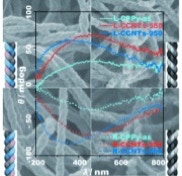
(3.2) Formation mechanism of chiral TiO 2 fibre
The optical chirality induced at the absorption bands due to electronic exciton coupling of the transition dipole moments between chromophores in close proximity is ubiquitous in helical organic materials. However, inorganic materials with optical activity resulting from electronic transitions have not been explored. Here we report the synthesis of chiral TiO 2 fibres via transcription of the helical structure of amino acid-derived amphiphile fibres through coordination bonding interactions between the organics and the TiO 2 source. Upon calcination, the as-prepared amorphous TiO 2 double-helical fibres with a pitch length of ~100 nm were converted to double-helical crystalline fibres with stacks of anatase nanocrystals in an epitaxial helical relationship. Both the amorphous and anatase crystalline helical TiO 2 fibres exhibited optical response to circularly polarized light at the absorption edge around ~350 nm. This was attributed to the semiconductor TiO 2 -based electronic transitions from the valence band to the conduction band under an asymmetric electric field. This work has been published on Nat. Commun., 2012, 3:1215.

(3.3) Formation mechanism of optically active chiral CuO“nanoflower”
Helical symmetry can be found in most flowers with a rotation of contort petal aestivation. For micro- and nanoscale analogies, flower mimicking structures have been reproduced; however, the conceptual chirality of “nanoflowers” has not yet been defined. Here, the chirality of the “flower” was defined by its nanosized chiral structure and consequent optical activity (OA), opening new horizons for the physical theory and chiral materials. We report the surfactant-mediated hydrothermal synthesis of chiral CuO nanoflowers using sodium dodecyl sulfate (SDS) as a structure-directing agent, an amino alcohol as a symmetry-breaking agent, and cupric salt as the inorganic source. Two levels of hierarchical chirality exist for a CuO nanoflower including primary helically arranged “nanoflakes” and secondary helical “subnanopetals” that form “nanopetals”. The nanoflowers exhibited a prominent optical response to circularly polarized light (CPL) at the absorption bands characteristic of CuO. This work has been published on J. Am. Chem. Soc., 2014, 136, 7193.
